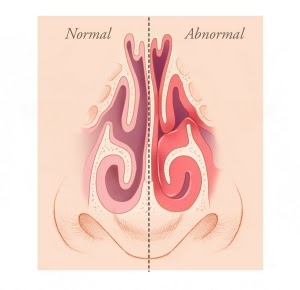Turbinates are the small membranes on the inside of the nose that work to warm, humidify and filter the air as it moves through the nostrils and into the lungs. The nose has inferior, middle, and superior turbinates on each side, each composed of a bony structure positioned within a casing of vascular tissue and mucous membrane. During what’s known as the “nasal cycle,” the turbinates activate by swelling with increased blood flow in response to irritants, stress, and hormonal changes.
This natural swelling can become problematic when the turbinates are too large. The inferior turbinates, located at the lowest part of the nose, are the largest pair and those that are most often the cause for turbinate-related breathing issues. When these turbinates become too large it’s called turbinate hypertrophy.1 The increase in size can usually be attributed to swelling due to rhinitis, infection, irritation, allergies, or anatomical irregularities such as irregularly situated turbinate bones. For those with enlarged turbinates, the swelling prompted by the nasal cycle can lead to congestion or even a nasal obstruction due to the production of an excessive amount of mucus.
For most, occasional congestion or a nasal obstruction caused by turbinate enlargement will go away on its own. However, a Turbinate Reduction procedure may be indicated for people who experience these symptoms frequently or need constant medication to combat them.

Source: Stanford Health
Contact plastic surgeon Dr. David Cangello today at (646) 665-4222 to schedule a consultation for Turbinate Reduction in NYC.
What Is Turbinate Reduction?
Turbinate Reduction surgery can correct a nasal obstruction, persistent congestion, and postnasal drip for patients struggling with turbinate hypertrophy. Depending on each patient’s needs, Dr. Cangello will determine the method he will use to reduce the size of your turbinates to decrease airway resistance while ensuring that the natural function of the turbinates is preserved.
Endoscopic Turbinate Reduction
An Endoscopic Turbinate Reduction is performed by Dr. Cangello under sedation or general anesthesia. Dr. Cangello will begin by making an incision in the lining mucosa of the turbinate and then removing excessive underlying bone. Depending on your specific needs, Dr. Cangello may use a device that heats and shrinks the mucosa from its undersurface in order to thin out the tissue surrounding the turbinate.
Simple Fracture Turbinate Reduction
When mucosal reduction is not necessary, a simple outward fracture of the bony prominence of the turbinates can be performed. For this procedure, no incision in the mucosa is necessary. A special instrument is inserted into the nose and the bone is easily fractured and moved into a more lateral position, thus opening the nasal passage.


Candidates For Turbinate Reduction Surgery
Candidates for Turbinate Reduction are men and women who are struggling with congestion or nasal obstructions whose symptoms do not respond to medications such as antibiotics, nasal sprays, or antihistamines.
Turbinate Reduction Risks & Recovery
Typically there is minimal or no pain during Turbinate Reduction recovery and no changes are necessary to your daily routine. You can expect to have crusting on the nose for roughly 3 weeks following your procedure. Dr. Cangello may recommend nasal saline irrigation and/or an antibiotic ointment during this time, as it can help with healing.2 You can rest assured that the Turbinate Reduction procedure won’t change the physical characteristics of your nose and long term side effects are highly uncommon.
You should plan to take one or two days off work for your procedure and avoid strenuous activity for at least one week following your procedure. Although rare, some risks include bleeding, infection, dryness, and scarring, and should be taken into consideration. Additionally, after Turbinate Reduction, there is a slight chance that the turbinates can enlarge again over time, making another procedure necessary.
Turbinate Reduction in NYC with Dr. Cangello
Contact NYC’s foremost nasal surgery expert today to learn more about Turbinate Reduction or to schedule a consultation.
References
1 Stanford Health Care. Turbinate Reduction. Available at: https://stanfordhealthcare.org/medical-treatments/n/nasal-surgery/types/turbinate-reduction.html#:~:text=Radiofrequency%20turbinate%20reduction%20is%20a,improved%20airflow%20through%20the%20nose. Accessed October 14, 2020.
2 Johns Hopkins Medicine. Turbinate Reduction. Available at: https://www.hopkinsmedicine.org/otolaryngology/specialty_areas/sinus_center/procedures/turbinate_reduction.html. Accessed October 15, 2020.
